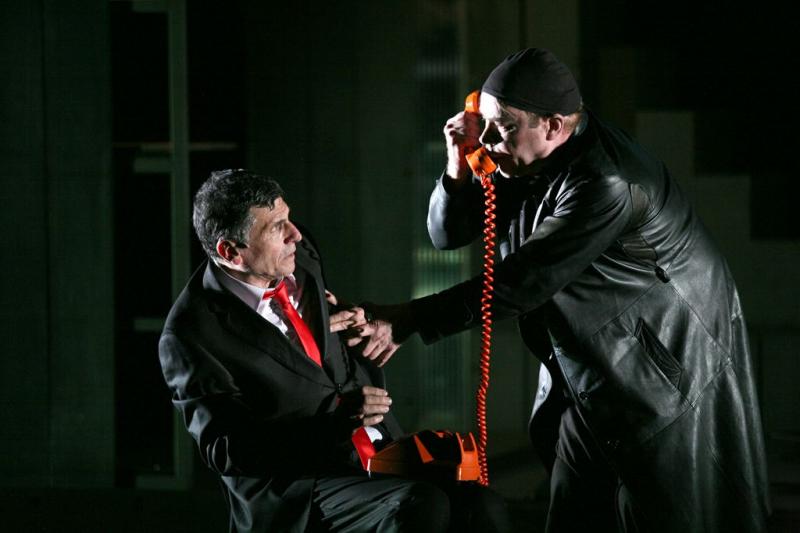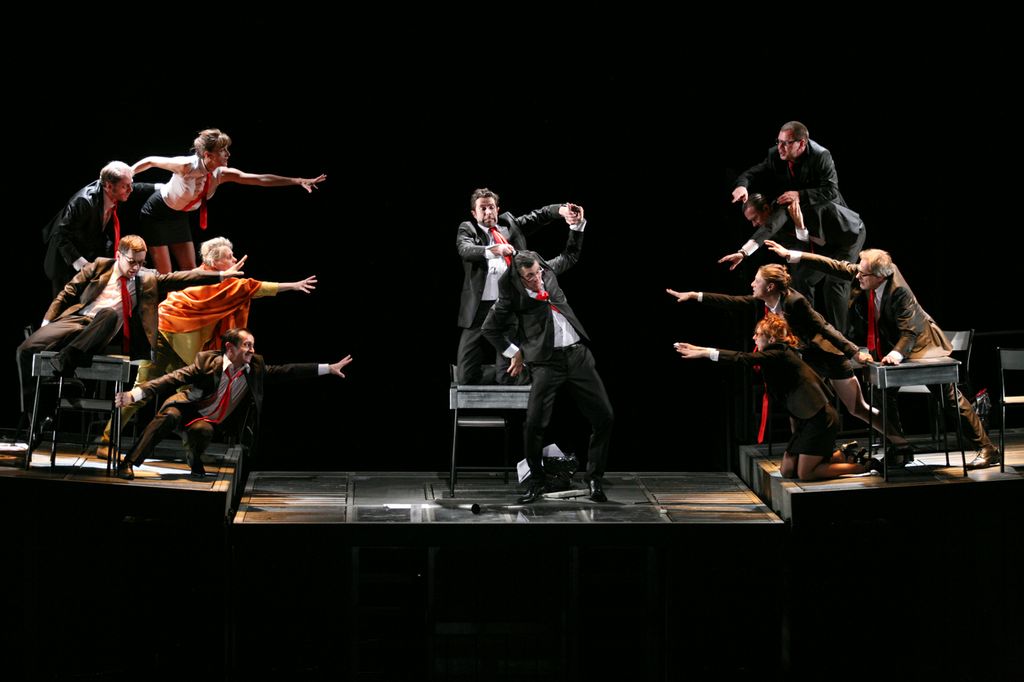Rhinocéros, Barbican Theatre | reviews, news & interviews
Rhinocéros, Barbican Theatre
Rhinocéros, Barbican Theatre
Ionesco's absurdist masterpiece delivered with pace and style by fine French ensemble

I laughed quite a bit going round the exhibition to which the Barbican’s latest theatre events are tied, The Bride and the Bachelors. Pioneer Marcel Duchamp’s 1921 “Readymade” Why Not Sneeze, Rrose Sélavy? is funny in itself: a metal birdcage containing marble sugarcubes with a cuttle bone and a thermometer stuck through the bars.
I laughed a lot, too, reading Eugène Ionesco’s Rhinocéros. I laughed rather less at a production which sometimes squashes the Romanian’s absurdist black humour under elegant French feet. But the Théâtre de la Ville-Paris’s clockwork precision and sure sense of pace do take us to the dark heart of a great play.
Elaborate mobile sets by Yves Collet are artworks in themselvesThe Parisians continue to keep Ionesco in the forefront of the dramatic repertoire while London theatre merely defers to his example in the abstract. Our long runner is The Mousetrap; Paris's is a double bill of Ionesco’s The Bald Primadonna and The Lesson, still to be seen at the tiny Théâtre de la Huchette 61 years after their first performances there.
Théâtre de la Ville parades its Ionesco on a bigger scale with an ensemble of 13 and elaborate mobile sets by Yves Collet which are artworks in themselves – but all in the cause of illuminating Emmanuel Demarcy-Mota’s initially fast-moving production which keeps the fable of Rhinocéros simple yet ambiguous. For Ionesco it was about the rise of Fascism, but as the pachydermal herd lacks a leader, it remains topical – a comic-serious riff on joining the pack, the latest fashion, the current opinion
That it’s the story of one man against a world bent on becoming beasts is made clear immediately by transposing a chunk of monologue for the protagonist, Bérenger, to the beginning of the play, before proper curtain up. He’s played with shabby gentleness by Serge Maggiani, following in the footsteps of Jean-Louis Barrault who created the role in 1960: part Molière outsider-hero, part Shakespearean soothsayer-clown (Demarcy-Mota and artistic collaborator François Regnault make this clear in a programme of enlightening articles, and they certainly practise what they preach). The provincial world in which Bérenger finds himself at odds would be funnier if it were less stylised, more realistic; the absurd breakthrough of an offstage rhino charge would have more of an impact too in the midst of the silly-mundane, but the direction and Jefferson Lembeye’s soundscape are intent on doomy portent. The mass activities of the second act’s office group aren’t terribly amusing either - collective typing on desks apart - until a worker turned rhino breaks down a staircase and the set slides, or rather elevates, into stylised chaos (pictured above).
The provincial world in which Bérenger finds himself at odds would be funnier if it were less stylised, more realistic; the absurd breakthrough of an offstage rhino charge would have more of an impact too in the midst of the silly-mundane, but the direction and Jefferson Lembeye’s soundscape are intent on doomy portent. The mass activities of the second act’s office group aren’t terribly amusing either - collective typing on desks apart - until a worker turned rhino breaks down a staircase and the set slides, or rather elevates, into stylised chaos (pictured above).
As Ionesco’s Theatre of the Absurd turns slowly to tragicomedy, the power of the individual acting beyond the crisp ensemble work asserts itself. Hugues Quester as Bérenger’s bullying friend Jean, a man seen on the edge from the start, convinces us he’s leathering up and turning green before our very eyes. Does the show deliver on Ionesco’s demand for “a lot of rhinoceros heads”? Available images don’t give the game away, so neither shall I; but suffice it to say that the last of the three acts, which run here compellingly without an interval, offers the most painterly visual coup. It’s a love scene with a very unValentineish conclusion between wounded Bérenger and secretary Daisy (Valérie Dashwood) played out in the near-dark. The Barbican Theatre’s black box fits this production as well as the gallery does the superb exhibition; go see them both, but be quick about it if you want to catch this Rhinocéros.
rating
Explore topics
Share this article
The future of Arts Journalism
You can stop theartsdesk.com closing!
We urgently need financing to survive. Our fundraising drive has thus far raised £49,000 but we need to reach £100,000 or we will be forced to close. Please contribute here: https://gofund.me/c3f6033d
And if you can forward this information to anyone who might assist, we’d be grateful.

Subscribe to theartsdesk.com
Thank you for continuing to read our work on theartsdesk.com. For unlimited access to every article in its entirety, including our archive of more than 15,000 pieces, we're asking for £5 per month or £40 per year. We feel it's a very good deal, and hope you do too.
To take a subscription now simply click here.
And if you're looking for that extra gift for a friend or family member, why not treat them to a theartsdesk.com gift subscription?
more Theatre
 Wendy & Peter Pan, Barbican Theatre review - mixed bag of panto and comic play, turned up to 11
The RSC adaptation is aimed at children, though all will thrill to its spectacle
Wendy & Peter Pan, Barbican Theatre review - mixed bag of panto and comic play, turned up to 11
The RSC adaptation is aimed at children, though all will thrill to its spectacle
 Hedda, Orange Tree Theatre review - a monument reimagined, perhaps even improved
Scandinavian masterpiece transplanted into a London reeling from the ravages of war
Hedda, Orange Tree Theatre review - a monument reimagined, perhaps even improved
Scandinavian masterpiece transplanted into a London reeling from the ravages of war
 The Assembled Parties, Hampstead review - a rarity, a well-made play delivered straight
Witty but poignant tribute to the strength of family ties as all around disintegrates
The Assembled Parties, Hampstead review - a rarity, a well-made play delivered straight
Witty but poignant tribute to the strength of family ties as all around disintegrates
 Mary Page Marlowe, Old Vic review - a starry portrait of a splintered life
Tracy Letts's Off Broadway play makes a shimmeringly powerful London debut
Mary Page Marlowe, Old Vic review - a starry portrait of a splintered life
Tracy Letts's Off Broadway play makes a shimmeringly powerful London debut
 Little Brother, Soho Theatre review - light, bright but emotionally true
This Verity Bargate Award-winning dramedy is entertaining as well as thought provoking
Little Brother, Soho Theatre review - light, bright but emotionally true
This Verity Bargate Award-winning dramedy is entertaining as well as thought provoking
 The Unbelievers, Royal Court Theatre - grimly compelling, powerfully performed
Nick Payne's new play is amongst his best
The Unbelievers, Royal Court Theatre - grimly compelling, powerfully performed
Nick Payne's new play is amongst his best
 The Maids, Donmar Warehouse review - vibrant cast lost in a spectacular-looking fever dream
Kip Williams revises Genet, with little gained in the update except eye-popping visuals
The Maids, Donmar Warehouse review - vibrant cast lost in a spectacular-looking fever dream
Kip Williams revises Genet, with little gained in the update except eye-popping visuals
 Ragdoll, Jermyn Street Theatre review - compelling and emotionally truthful
Katherine Moar returns with a Patty Hearst-inspired follow up to her debut hit 'Farm Hall'
Ragdoll, Jermyn Street Theatre review - compelling and emotionally truthful
Katherine Moar returns with a Patty Hearst-inspired follow up to her debut hit 'Farm Hall'
 Troilus and Cressida, Globe Theatre review - a 'problem play' with added problems
Raucous and carnivalesque, but also ugly and incomprehensible
Troilus and Cressida, Globe Theatre review - a 'problem play' with added problems
Raucous and carnivalesque, but also ugly and incomprehensible
 Clarkston, Trafalgar Theatre review - two lads on a road to nowhere
Netflix star, Joe Locke, is the selling point of a production that needs one
Clarkston, Trafalgar Theatre review - two lads on a road to nowhere
Netflix star, Joe Locke, is the selling point of a production that needs one
 Ghost Stories, Peacock Theatre review - spirited staging but short on scares
Impressive spectacle saves an ageing show in an unsuitable venue
Ghost Stories, Peacock Theatre review - spirited staging but short on scares
Impressive spectacle saves an ageing show in an unsuitable venue
 Hamlet, National Theatre review - turning tragedy to comedy is no joke
Hiran Abeyeskera’s childlike prince falls flat in a mixed production
Hamlet, National Theatre review - turning tragedy to comedy is no joke
Hiran Abeyeskera’s childlike prince falls flat in a mixed production

Add comment